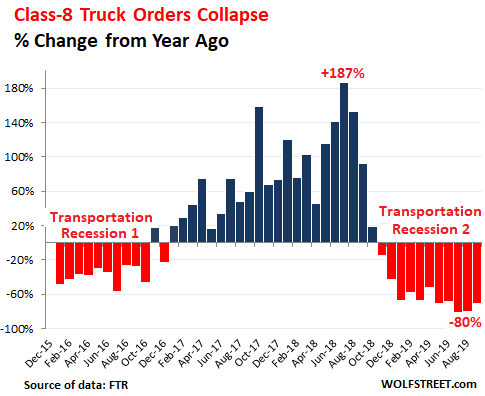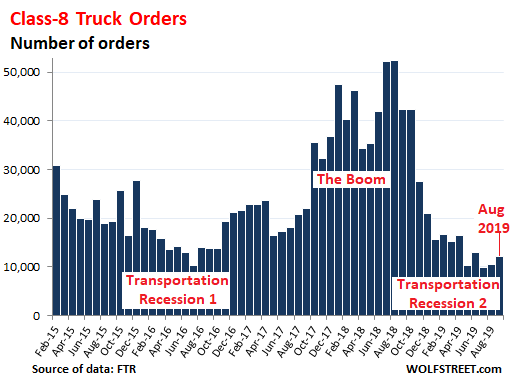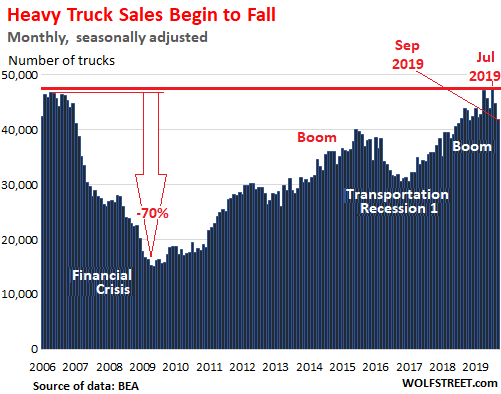“Fleets are nervous. The latest manufacturing and construction numbers are concerning. The trade issue with China looms.”
Layoff decisions by heavy-truck manufacturers are trickling out. A couple of days ago, it was Daimler-owned Freightliner, which said in a statement to WBTV that it would “adjust its production output in line with lower market demand and release approximately 450 production workers [out of 2,878 employees] at its Cleveland manufacturing plant based in Cleveland, North Carolina, and approximately 450 workers [out of 1,714 employees] in Mt. Holly, North Carolina, effective October 14, 2019.” These layoffs represent 16% and 26% of the workforce at the respective plants.
Orders for heavy trucks, after a red-hot period that ended in the fall of 2018, have been in a horrific plunge. In September 2019 compared to September last year, truck makers received about 12,100 orders for Class-8 trucks, down 71% from a year ago, according to preliminary estimates by FTR Transportation Intelligence. It was the 11th month in a row of year-over-year declines, including July and August plunges of 80%:

“Fleets are moving around, or canceling orders previously placed but are not ordering many new trucks for Q4 delivery,” FTR said in the statement. “Carriers have not begun ordering for 2020 requirements yet, due to the tariffs and the economic uncertainty.”
Class-8 orders “are stuck at the bottom of the cycle,” said FTR vice president, commercial vehicles, Don Ake, adding: “Fleets are nervous. Freight growth continues to ease back. The latest manufacturing and construction numbers are concerning. The trade issue with China looms. In this environment, fleets see no reason to begin ordering for 2020 until Q4.”
The shipment boom in 2017 and 2018, as a result of front-running potential tariffs, triggered rumors of a “capacity crisis” among trucking companies, which then engaged in a historic ordering boom in 2018 to expand their capacity to be able to handle the shipment boom. But then in late 2018, overall freight shipments in the US suddenly began to fall, and have fallen ever since, and it was over.
The chart shows this boom in orders for Class-8 trucks and then the sharp drop-off in orders down to historically low levels where they appear to have gotten “stuck”:

As a result of the historic ordering boom in 2018, truck makers accumulated an equally historic backlog for building 2019 models, and the subsequent collapse in orders that started late last year was buffered by this backlog, and truck deliveries hit record highs months after orders had begun to collapse.
Truck makers recognize a sale when the truck is delivered to the customer, which is months after the truck was ordered. For the industry overall, truck sales, as measured in deliveries, surged during 2018 and into 2019, to hit 47,300 deliveries in July (seasonally adjusted), surpassing the peak before the Financial Crisis, according to data by the Commerce Department.
But in August, deliveries fell, and in September deliveries fell again, to 41,800 (seasonally adjusted), down 4.6% from September last year, the first year-over-year decline since the March 2017. These deliveries are still all 2019 models for which orders closed some time ago:

Truck makers don’t disclose their order backlogs. But when production cuts and layoffs start, it’s safe to assume that much of the order backlog has been built and delivered. Now deliveries are declining, and the layoffs are starting.
This is likely what is happening at Freightliner, where layoffs are set to begin on October 14. The company said in its statement to WBTV, referring to the order boom last year, and its untimely end:
This levelling-off in the market requires us to adjust our production levels to meet the normalized demand and therefore reduce our current build rates and employment levels at these locations. We have already witnessed some of our industry competitors making changes in their production plans and employment levels to accommodate.
Daimler also owns Western Star, and their industry competitors are Peterbilt and Kenworth, divisions of Paccar [PCAR]; Navistar International; and Mack Trucks and Volvo Trucks, divisions of Volvo Group. Navistar already announced layoffs in its medium-duty truck division.
What’s next for truck makers? Note Freightliner’s description of “normalized demand.” This is probably an accurate description of a market that had been totally distorted by the tariff-frontrunning boom, and now struggles with the harsh return to “normal.” The cyclicality of this industry is legendary, but even for this cyclical industry, the ordering boom in 2018 and the current order collapse is extreme.
As the backlog dwindles further, there will be further production cuts and layoffs until capacity is roughly in line with incoming demand for trucks.
The level of orders over the past five months in the 10,000 to 13,000-unit range is catastrophically low – about half of the industry capacity – and is likely a counter-reaction to the boom. At some point, the excesses will be worked off, and this catastrophically low level of orders will tick higher. But the cloud 9 that truck makers had been on until summer this year will likely not return anytime soon.
What US Freight Shipments and Pricing Say About the Slowdown. Read… Light at End of Tunnel or Oncoming Train for the Goods-Based Economy?
Enjoy reading WOLF STREET and want to support it? You can donate. I appreciate it immensely. Click on the mug to find out how:
![]()


Shippers tried to front load Asians goods before tariffs hit them. Truckers heavily ordered new trucks and whatnots. But tariff wars did not shift to shippers so trucks orders being massively cut to the bone. Cuts in rails, boats Continue while the consumers are maxed out to their eyeballs!
Guess the economy will tank much faster and very soon!
I also wonder how much the new bonus depreciation included in the tax cut act of 2017 pulled demand forward. I’ve read a few accounts of this. This may be an underappreciated aspect of the slump.
“Tariffs” and “Brexit” are the new “My uncle’s dog ate my homework teacher, honest”: a ready made excuse for everything, and a lazy one as well. The only difference is no teacher would fall for it, while supposedly cynical and sophisticated financial markets will eat up everything without question. Remember WeWork’s $47 billion valuation?
Wolf warned us time and time again trucking is highly cyclical business, with years of fat cows followed by years of lean cows, and not even funny money, the kind that makes losing as much as money as Netflix and Uber do possible, could break that cycle.
My only bone is that this round the lean cows could stick around a bit more for two reasons.
First is that in 2017 so much growth was forecast regular order books were inflated to front-run all that future growth. Put it this way: instead of ordering 1,000 truck, make that 1,200, just to err on the safe side.
Second is that we frontrun so much manufacturing growth in 2016-2018 we now have to live with the consequences. Not a recession, but some kind of high plateau with a ton of the usual mindless Wall Street propaganda around it (“PMI rebounds in Zambodia!”, “Strong economic growth in Hedonia!” etc).
Personally I am looking at the cargo aircraft market. After running into a series of mind-boggling technical issues, the first Airbus A320 and 321 cargo conversions are now being delivered to customers. The first Boeing 737-800 freighters were delivered earlier this year, albeit a lack of suitable conversion stock will affect deliveries for at very least a couple of years. Capacity has been growing at a steady 3.5-4% over the past five years but volume growth worldwide is anemic, in the 1.5-2% range, and mostly driven by e-commerce. The Asian boom has already happened, the US suffers from growing overcapacity and Europe stagnates.
In short worldwide overcapacity looms but fares remain very high: it’s like eating the cake and having it too and we all know that cannot last forever.
I think the market hears you.
FedEx at 5 year lows.
If this is the same Mr Market that still gives Netflix (big losses) a $116 billion market cap and Uber (even bigger losses) a $50 billion market cap I’d take his judgement with a pinch of salt.
Well, that is the beauty of the market.
You are more than welcomed to determine where the market is wrong and put up money to profit from that determination.
Mr. Market went on a permanent vacation a long time ago. We are now taking orders from the banking equivalent of Saddam Hussein, who says you will have no food in retirement unless you invest in inflated stocks now.
We all know what Saddam did when confronted with the error of his ways. He dug a hole and hid in it.
“Well, that is the beauty of the market.
You are more than welcomed to determine where the market is wrong and put up money to get roasted when central banks move Heaven and Earth to maintain nosebleed valuations at all costs ignoring all moral hazard and ethics.”
FIFY.
The store is on fire and the looters are grabbing all they can get their hands on before the first structural element fails.
FIFY.
Just buy Gold and be done with it Yourll thank me later Oh and some silver too physical metal only NO paper nonsense
Frederick – I was taught growing up that the only way to save is US Savings Bonds, so I guess those are viable, but only if they are paper bonds you can hold in your hand. I’ll agree gold and things like diamonds may be better, and easier to smuggle out of the US if you have to make a quick escape – it really feels like early 30s Germany out there.
My take on the market –
With very low to negative interest rates and periodic bouts of QE, any mechanism for price discovery is broken. Traditional “buy and hold” investing simply won’t work in this environment, as the associated risk increases and reward diminishes with inflated prices.
On the other hand, the money flows in the market are going to be higher than ever. More “liquidity” means bigger waves. Ironically, the bulk of investment money has turned to passive investing strategies like ETF’s while the big opportunities are in active management following trends of money flows.
Look back to a chart of the market in the 1970’s … buy and hold didn’t work that decade, but there were big gyrations in valuation. Back then you had solid dividends to help buffer your returns, but now there is very little of that … stock buybacks are preferred today, but these tend to make the waves bigger and more dangerous rather than giving any returns to long-term holders.
Last thing … the chart technicals are much more important than macro direction here. Remember that valuation is broken, so a macro story that seems solid could lead to highly overbought stocks while a weak one may jump based on higher expectations of QE combined with relatively low valuations.
Anyone ordering a new truck to ‘front run’ tariffs that are a whim of the WH and could disappear in a tweet was silly and is now stuck with a truck (s) lacking work .
Heavy truck sale begin to fall, but thanks to e-commerce
Ford transit sales are booming, benefiting from online deliveries.
Ford offer the whole spectrum from transit, pickup trucks
and heavy duty trucks.
I concur. With 50K less brick and mortar points to deliver to ( and falling)and more point to point distribution point deliveries it seems a serious percentage of class 8 going down to the transit type vans for the final mile delivery segment.
Fuel prices are on the rise, the real recession question is what kind of event will it be? Consumer pullback? Inflation? Jobs? Consumer confidence has been in decline, Santa Claus rally in stocks carries no wealth effect? China is not going to curtail production, (if any of it gets here untariffed) By that insightful article on NIRP maybe a credit recession. Like gasoline, consumer credit at the margin might become tight and more expensive.
US churches are notorious for not doing a thing for people who’ve been tithing members for years, and then become homeless etc.
In all fairness, giving soup to hungry people can get you put into prison in the US.
You forgot the most probable one Deflationary debt collapse followed by hyperinflation Its already started hasn’t it
There is a good article on the SRSRocco site
More Than 50% Of The Mighty Permian’s 2018 Oil Production Has Vaporized
Given that conventional oil peaked in 05 and shale has been the only thing between us and $300 oil (or higher), then oil is likely to march higher in the near future.
That will destroy growth and collapse the economy
Folks, we don’t need to fight over what will collapse the economy! We’re adults. We don’t believe in economic charicatures. D) All of the above!
But the thing that will collapse the trucking industry is Tesla disrupting the s#!t out of it with Semi. Sorry, but I HAD to bring Tesla into it! I know, everyone loves to hate on Tesla around here, but let’s stop confusing Wall Street with reality. The technology is real, and it is going to disrupt (gag) the industry.
Road and rail transport is a finger on the pulse of the US economy, just like te Baltic Dry Index is for world trade.
Interestingly good ol DJT precursor to indexes is somehow holding up around 10k or the bottoms of last 2 yrs.
Better trucking artificial intelligence algorithms and Amazon regional distribution warehouses may have reduced hauling partial or empty loads. Consumer spending continues.
Boeing 737 Max planes have been grounded since March.
Most of these data points today function to simply reinforce confirmation bias. The fact of the matter is that the signal to noise in this economy is low, the Fed and the Federal Government are players of enormous scope and power (and not disinterested players, either), and years of market manipulation have left us with little idea of how weak or strong the economy really is. I am cautious making any claims, other than empirical ones, about where we are at, and even those are tough as the numbers themselves seem open to manipulation and revision. Where we are headed is opaque.
I’m not sure the runup and collapse in truck sales was totally caused by economic conditions. California mandated the replacement of engines in trucks operating in California with new “cleaner” engines (that break down more often). I believe this started in 2010, As of the beginning of 2020, no trucks with engines built before 2001 may run in CA without retrofits. I believe this is what caused the up slope on truck sales over the last 10 years. Sales collapse may be partially attributed to the fact that most trucks have now been replaced. I had seven fine running trucks “outlawed” with no compensation given for their “taking”.